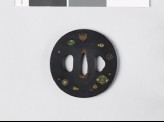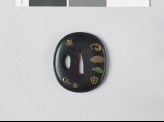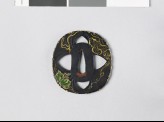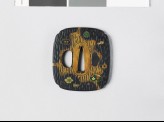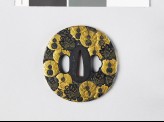The A. H. Church Collection of Japanese Sword-Guards (Tsuba)
An unpublished catalogue of the A. H. Church collection of Japanese sword-guards (tsuba) by Albert James Koop.
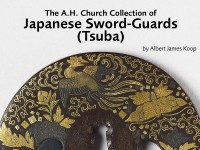
The art of shippō-yaki or enamelling, i.e. the fusing of coloured vitreous pastes on a metal base, was known to the Japanese at a very early period, but was subsequently lost until towards 1600, when the trade with China led to its revival. At this latter date it was much used for various small objects, but not for vases, bowls, dishes and the like, this class of work not appearing in Japan before the middle of the 19th century.
The use of fine cloisonné work on sword-furniture begins with Hirata [Japanese text] Dōnin (d. 1646), who was sole court enameller to the Tokugawa Shōgun and was succeeded in that post by ten of his descendants in turn. Their enamels are for the most part in gold cloisons and are inlaid in iron, shakudō or other metal grounds. A peculiar feature is the addition of tiny spirals and scrolls (“Hirata curls”) in inlay of gold wire.
Translucent enamel appears first about 1770, in the time of the 7th Master, Narisuke (d. 1816); but during the 19th century many older pieces were re-decorated with cloisonné enamels of this nature.
The coarse enamelling done on Hirado and Nagasaki work is illustrated in [another chapter] and at the beginning of the present group respectively.
Champlevè work
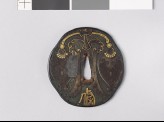 Octagonal tsuba with Chinese pendent (EAX.11143)
Octagonal tsuba with Chinese pendent (EAX.11143)
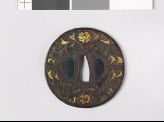 Round tsuba with flowers, foliage, and dragons (EAX.11144)
Round tsuba with flowers, foliage, and dragons (EAX.11144)
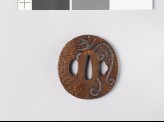 Tsuba with 'long life' character, butterfly, and leaves (EAX.11145)
Tsuba with 'long life' character, butterfly, and leaves (EAX.11145)
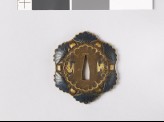 Hexagonal tsuba with palmettes (EAX.11146)
Hexagonal tsuba with palmettes (EAX.11146)
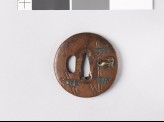 Lenticular tsuba with bamboo stems and tigers (EAX.11147)
Lenticular tsuba with bamboo stems and tigers (EAX.11147)
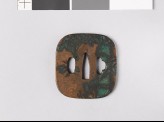 Tsuba with bamboo (EAX.11148)
Tsuba with bamboo (EAX.11148)
 Lobed tsuba with ovals (EAX.11149)
Lobed tsuba with ovals (EAX.11149)
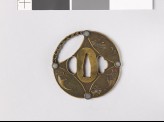 Round tsuba in the form of a shippō diaper, with Luck Objects (EAX.11150)
Round tsuba in the form of a shippō diaper, with Luck Objects (EAX.11150)
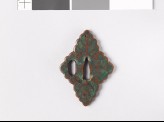 Tsuba in the form of four leaves (EAX.11151)
Tsuba in the form of four leaves (EAX.11151)
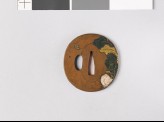 Tsuba with turnip and butterfly (EAX.11152)
Tsuba with turnip and butterfly (EAX.11152)
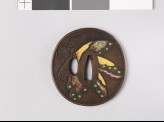 Tsuba with butterflies (EAX.11153)
Tsuba with butterflies (EAX.11153)
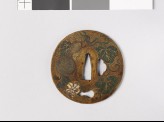 Tsuba with double-gourd plants (EAX.11154)
Tsuba with double-gourd plants (EAX.11154)
 Tsuba with blossoming plum tree (EAX.11155)
Tsuba with blossoming plum tree (EAX.11155)
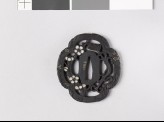 Mokkō-shaped tsuba with rain dragon and blossoming plum tree (EAX.11156)
Mokkō-shaped tsuba with rain dragon and blossoming plum tree (EAX.11156)
Cloisonnè enamel
(Usually translucent and in gold cloisons.)
 Lobed tsuba with chrysanthemum mon and scrolls (EAX.11157)
Lobed tsuba with chrysanthemum mon and scrolls (EAX.11157)
 Tsuba with nightingale, plum tree, and purple clouds (EAX.11158)
Tsuba with nightingale, plum tree, and purple clouds (EAX.11158)
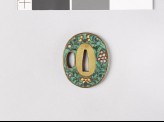 Tsuba with flowers, clouds, and karakusa, or scrolling plant pattern (EAX.11159)
Tsuba with flowers, clouds, and karakusa, or scrolling plant pattern (EAX.11159)
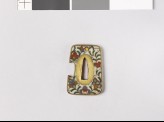 Aori-shaped tsuba with flowers, clouds, and karakusa, or scrolling plant pattern (EAX.11160)
Aori-shaped tsuba with flowers, clouds, and karakusa, or scrolling plant pattern (EAX.11160)
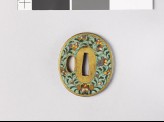 Tsuba with flowers and karakusa, or scrolling plant pattern (EAX.11161)
Tsuba with flowers and karakusa, or scrolling plant pattern (EAX.11161)
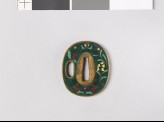 Tsuba with flowers and clouds (EAX.11162)
Tsuba with flowers and clouds (EAX.11162)
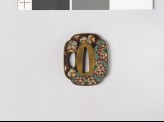 Mokkō-shaped tsuba with chrysanthemums, plum blossoms, and clouds (EAX.11163)
Mokkō-shaped tsuba with chrysanthemums, plum blossoms, and clouds (EAX.11163)
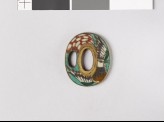 Tsuba with phoenix and clouds (EAX.11164)
Tsuba with phoenix and clouds (EAX.11164)
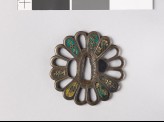 Tsuba in the form of a chrysanthemum mon (EAX.11165)
Tsuba in the form of a chrysanthemum mon (EAX.11165)
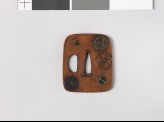 Aori-shaped tsuba depicting charms, coins, and three of the Seven Treasures (EAX.11166)
[obj]EAX.11167[/obj]
Aori-shaped tsuba depicting charms, coins, and three of the Seven Treasures (EAX.11166)
[obj]EAX.11167[/obj]
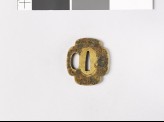 Tsuba with kiku-karakusa, or floral scrolls (EAX.11168)
Tsuba with kiku-karakusa, or floral scrolls (EAX.11168)
 Tsuba with conventional ornament (EAX.11169)
Tsuba with conventional ornament (EAX.11169)
 Octagonal tsuba with plum tree and ground bamboo (EAX.11170)
Octagonal tsuba with plum tree and ground bamboo (EAX.11170)
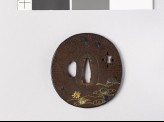 Tsuba with wild geese and shells (EAX.11171)
Tsuba with wild geese and shells (EAX.11171)
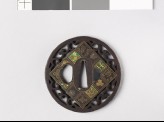 Round tsuba with flowers and scrolls (EAX.11172)
Round tsuba with flowers and scrolls (EAX.11172)
 Round tsuba with trees and flowers (EAX.11173)
Round tsuba with trees and flowers (EAX.11173)
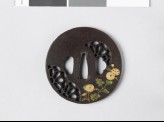 Round tsuba with chrysanthemum mon (EAX.11174)
Round tsuba with chrysanthemum mon (EAX.11174)
Notice
Object information may not accurately reflect the actual contents of the original publication, since our online objects contain current information held in our collections database. Click on 'buy this publication' to purchase printed versions of our online publications, where available, or contact the Jameel Study Centre to arrange access to books on our collections that are now out of print.
© 2013 University of Oxford - Ashmolean Museum

